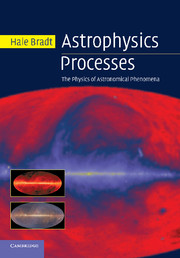Book contents
- Frontmatter
- Contents
- List of figures
- List of tables
- Preface
- Acknowledgments
- Also by the author
- 1 Kepler, Newton, and the mass function
- 2 Equilibrium in stars
- 3 Equations of state
- 4 Stellar structure and evolution
- 5 Thermal bremsstrahlung radiation
- 6 Blackbody radiation
- 7 Special theory of relativity in astronomy
- 8 Synchrotron radiation
- 9 Compton scattering
- 10 Hydrogen spin-flip radiation
- 11 Dispersion and Faraday rotation
- 12 Gravitational lensing
- Credits, further reading, and references
- Glossary
- Appendix: Units, symbols, and values
- Index
6 - Blackbody radiation
Published online by Cambridge University Press: 05 June 2012
- Frontmatter
- Contents
- List of figures
- List of tables
- Preface
- Acknowledgments
- Also by the author
- 1 Kepler, Newton, and the mass function
- 2 Equilibrium in stars
- 3 Equations of state
- 4 Stellar structure and evolution
- 5 Thermal bremsstrahlung radiation
- 6 Blackbody radiation
- 7 Special theory of relativity in astronomy
- 8 Synchrotron radiation
- 9 Compton scattering
- 10 Hydrogen spin-flip radiation
- 11 Dispersion and Faraday rotation
- 12 Gravitational lensing
- Credits, further reading, and references
- Glossary
- Appendix: Units, symbols, and values
- Index
Summary
What we learn in this chapter
A photon gas in perfect thermal equilibrium with its surroundings at some temperature T will exhibit an energy spectrum of a specific amplitude and shape known as the blackbody spectrum, which was first proposed by Max Planck in 1901. In its form as a specific intensityI(ν) (W m−2 Hz−1 sr−1), the blackbody spectrum peaks at a frequency proportional to its temperature. At low frequencies (the Rayleigh–Jeans approximation), it increases linearly with temperature and quadratically with frequency. At high frequencies (the Wien approximation), it decreases quasi-exponentially. The energy density, ∝ T4, and photon number density, ∝ T3, follow directly from I(ν). The former is closely related to the pressure of a photon gas, whereas the latter is closely related to the distribution function, the number density in six-dimensional phase space. Calculation of the average photon energy yields 2.70 kT.
The total energy flux (W) passing in one direction through a unit surface is proportional to T4. A normal gaseous (spherical) star emits a spectrum that approximates (roughly) that of a blackbody, which allows the luminosity to be expressed in terms of the stellar radius and an effective temperature. Momentum transfer by the photons to a hypothetical surface yields a pressure that is one-third the energy density. The blackbody flux is the maximum intensity that can be obtained from a thermal body. […]
- Type
- Chapter
- Information
- Astrophysics ProcessesThe Physics of Astronomical Phenomena, pp. 205 - 232Publisher: Cambridge University PressPrint publication year: 2008



